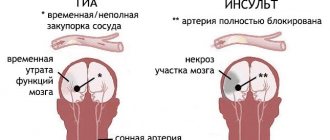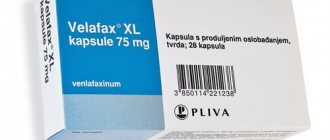Pharmacological properties of the drug Seroquel
An atypical antipsychotic drug that interacts with various types of neurotransmitter receptors. Quetiapine exhibits a higher affinity for serotonin receptors (5HT2) than for dopamine D1 and D2 receptors in the brain, as well as a high affinity for histamine and α1-adrenergic receptors and a lower affinity for α2-adrenergic receptors. It has no affinity for M-cholinergic receptors and benzodiazepine receptors, and exhibits antipsychotic activity. When studying extrapyramidal symptoms in an experiment, it was found that quetiapine causes only mild catalepsy when used in a dose that effectively blocks dopamine D2 receptors. Quetiapine causes a selective reduction in the activity of mesolimbic A10-dopaminergic neurons compared to A9-nigrostriatal motor neurons and has minimal effects on muscle tone in neuroleptic-sensitive monkeys. Quetiapine does not cause an increase in serum prolactin levels. The drug effectively eliminates both positive and negative symptoms of schizophrenia. When taken orally, it is well absorbed and actively metabolized. Food intake does not have a significant effect on the bioavailability of quetiapine. The main metabolites do not have pronounced pharmacological activity. The half-life is about 7 hours. Approximately 83% of quetiapine is bound to plasma proteins. Effective when taken 2 times a day. The effect of quetiapine on 5HT2 and D2 receptors lasts up to 12 hours, which is confirmed by positron emission tomography data. The pharmacokinetics of quetiapine is linear; there are no differences in the pharmacokinetics of the drug in men and women. The average clearance of quetiapine in elderly patients is 30–50% lower than in patients aged 18–65 years. Quetiapine clearance is reduced by 25% in patients with severe renal impairment (creatinine clearance less than 30 ml/min/1.73 m2) and in patients with liver damage (compensated alcoholic cirrhosis), but individual clearance levels are within the range corresponding to healthy people . Less than 5% of quetiapine is not metabolized and is excreted unchanged in urine or feces. Approximately 73% of quetiapine is excreted in urine and 21% in feces. The key enzyme in the metabolism of quetiapine is CYP 3A4, mediated by cytochrome P450. Quetiapine and some of its metabolites have a weak inhibitory effect on the enzymes cytochrome P450, 1A2, 2C9, 2C19, 2D6 and 3A4, but only at concentrations 10–50 times higher than the concentrations achieved when used at the usual dose (300–450 mg/day). In vitro , the ability of quetiapine to cause significant inhibition of the activity of cytochrome P450 and to influence the metabolism of other drugs mediated by it has not been established.
Contraindications
Absolute:
- glucose-galactose malabsorption, lactase deficiency and galactose intolerance;
- age under 18 years;
- combined use with cytochrome P450 inhibitors, including azole antifungals, clarithromycin, erythromycin, nefazodone and protease inhibitors;
- hypersensitivity to any of the components of the drug.
Relative (take Seroquel Prolong tablets with extreme caution):
- liver failure;
- cerebrovascular and cardiovascular diseases or other conditions predisposing to arterial hypotension;
- risk of stroke and aspiration pneumonia;
- history of seizures;
- elderly age.
Use of the drug Seroquel
Adults orally 2 times a day during meals or between meals. Treatment of schizophrenia The daily dose in the first 4 days of therapy is: 1st day of treatment - 50 mg/day, 2nd day - 100 mg/day, 3rd day - 200 mg/day, 4th day - 300 mg/day. days Starting from the 4th day, the dose is titrated until the required clinical effect is achieved in the range from 300 to 450 mg/day. Depending on the clinical effectiveness and tolerability of the drug, the dose can vary from 150 to 750 mg/day. Treatment of manic episodes associated with bipolar disorders The daily dose in the first 4 days of treatment is: 1st day - 100 mg/day, 2nd day - 200 mg/day, 3rd day - 300 mg/day, 4th day - 400 mg/day. Subsequently, the dose is increased by no more than 200 mg daily, up to a dose of 800 mg/day starting from the 6th day of treatment. Depending on the clinical effectiveness and tolerability of the drug, the dose can vary from 200 to 800 mg/day. Elderly Patients Like other antipsychotic drugs, Seroquel should be used with caution in elderly patients, especially at the initial stage of therapy. In such patients, the initial dose of the drug should be 25 mg/day. Subsequently, the dose is increased every day by 25–50 mg until an effective dose is reached, which is usually lower than in young patients. Hepatic or renal impairment: In patients with renal or hepatic impairment, oral clearance of quetiapine is reduced by approximately 25%. Quetiapine is extensively metabolized in the liver and should therefore be used with caution in patients with impaired liver function. For such patients, the drug is prescribed at an initial dose of 25 mg/day. Then the dose is increased every day by 25-50 mg until an effective dose is reached.
How long does the syndrome last?
The above variables also affect the duration of symptoms of the syndrome.
Initial signs of withdrawal appear within the first four days after the end of pharmaceutical therapy. Often the duration and severity of manifestations is influenced by the duration of the course of taking the antipsychotic.
The doctor who monitors the completion of Seroquel takes measures to gradually reduce the dosage of the main active ingredient - quetiapine. The effect of the active substance in the active phase lasts about 12 hours. After this time, the drug itself leaves the body. But the work of the nerve centers is disrupted by the antipsychotic.
If the dose is already minimal – 25 mg. (one tablet per day), then there are intervals between doses of one or two days.
The duration of the gradual reduction should be a time interval of four to eight weeks. In this case, it will be possible to minimize the symptoms and duration of the body’s withdrawal from the antipsychotic drug.
However, already during the period of decline, a stable withdrawal syndrome may form. In this case, it is possible to correct the course with a short-term increase in dose to restore the initial state. After this, the dosage reduction is resumed.
The maximum duration of the condition lasts up to 28 days. This time is enough to restore the original state of the neurons of the central nervous system.
https://myweak.ru/zavisimosti/lekarstva-zavisimosti/serokvel-sindrom-otmeny.html
Side effects of the drug Seroquel
The most frequently reported side effects were drowsiness, dizziness, dry mouth, asthenia, constipation, tachycardia, orthostatic hypotension, and dyspepsia. As with treatment with other antipsychotic drugs, neuroleptic malignant syndrome, leukopenia, and peripheral edema were noted when using Seroquel. The incidence of side effects associated with the use of Seroquel is presented in the table.
Frequency | Organ and organ systems | Reaction |
| Very common (≥10%) | Nervous system | Dizziness 1, 5, drowsiness 2 |
| Common (≥1% but ≤10%) | Hematopoietic and lymphatic systems | Leukopenia |
| The cardiovascular system | Tachycardia 1.5, orthostatic hypotension 1.5 | |
| Digestive system | Dry mouth, constipation, dyspepsia | |
| General violations | Mild asthenia, neuroleptic malignant syndrome 1, peripheral edema, decreased neutrophil count 6, increased blood glucose to hyperglycemic levels 7, weight gain 3 | |
| Laboratory indicators | Increased activity of serum transaminases (ALAT, AST) 4 | |
| Nervous system | Loss of consciousness 1, 5 | |
| Respiratory system | Rhinitis | |
| Rare (≥0.1% but ≤1%) | Hematopoietic and lymphatic systems | Eosinophilia, neutropenia |
| The immune system | Hypersensitivity | |
| Laboratory indicators | Increased activity of γ-glutaryltransferase, TG and total cholesterol levels in blood plasma | |
| Nervous system | Cramps 1 | |
| General violations | Neuroleptic malignant syndrome 1 | |
| Reproductive system | Priapism |
1 See SPECIAL INSTRUCTIONS. 2 Drowsiness may develop in the first 2 weeks of treatment and, as a rule, disappears with prolonged use of the drug. 3 Occur, as a rule, at the beginning of treatment. 4 Asymptomatic increases in serum transaminase activity (ALT, AST, or gamma-glutaryltransferase) developed only in some patients taking Seroquel. These changes resolved with prolonged treatment. 5 Like other antipsychotic drugs with α-adrenergic blocking activity, Seroquel can cause the development of orthostatic hypotension, which is manifested by dizziness, tachycardia and, in some patients, loss of consciousness (especially at the beginning of treatment). 6 In placebo-controlled monotherapy studies in patients with baseline neutrophil counts ≥1.5 × 109/L, the incidence of at least one episode of neutrophil count ≤1.5 × 109/L was 1.72% in patients taking quetiapine. compared with 0.73% in patients taking placebo. In all clinical studies (placebo-controlled, open-label, active comparator; patients with baseline neutrophil count ≥1.5 x 109/L), the incidence of at least one episode of neutrophil count decline ≤1.5 x 109/L was 0.21% in patients treated with quetiapine and 0% in patients treated with placebo; incidence of ≥0.5–≤1×109/L was 0.75% in patients treated with quetiapine and 0.11% in patients treated with placebo. who used placebo. 7 At least 1 episode of glucose ≥126 mg/dL or fasting glucose ≥200 mg/dL.
Seroquel therapy was sometimes accompanied by a slight dose-dependent decrease in the level of thyroid hormones in the blood (total T4 and unbound T4). The maximum decrease in total and unbound T4 was observed during the first 2-4 weeks of quetiapine therapy, without further decrease in hormone levels with prolonged treatment. In almost all cases, cessation of treatment resulted in normalization of total T4 and free T4 levels, regardless of the duration of treatment. A slight decrease in the level of total T3 was noted only when using the drug in a high dose. The level of thyroxine-binding globulin did not change, and no increase in the level of thyroid-stimulating hormone was noted. No signs of hypothyroidism were noted while taking Seroquel. Very rarely, the development of hyperglycemia and decompensation of diabetes mellitus has been reported during treatment with quetiapine. As with other antipsychotic drugs, quetiapine therapy may be accompanied by weight gain, mainly in the first weeks of treatment. Like other antipsychotic drugs, quetiapine may cause an increase in the QTc on the ECG, but in clinical studies there was no relationship between the use of the drug and a persistent increase in QTc .
Special instructions for the use of Seroquel
The maximum daily dose of Seroquel for the treatment of schizophrenia is 750 mg; for the treatment of manic episodes associated with bipolar disorders, this dose should be 800 mg. Long-term treatment with the drug at a high dose is possible only if the expected benefit outweighs the potential risk. Cardiovascular diseases The drug should be used with caution in patients with cerebrovascular diseases, diseases of the cardiovascular system or other conditions leading to the development of hypotension. The risk of developing orthostatic hypotension is higher during the initial period of dose selection, especially in elderly patients. The results of clinical studies did not reveal a relationship between the use of quetiapine and a persistent increase in the QT . However, like other antipsychotic drugs, caution should be exercised when quetiapine is prescribed concomitantly with drugs that prolong the QT , especially in the elderly. Convulsive seizures Caution should also be exercised when prescribing to patients with a history of seizures. Tardive dyskinesia Long-term use of Seroquel, like other antipsychotic drugs, can cause tardive dyskinesia. In this case, you should reduce the dose or discontinue the drug. Neuroleptic malignant syndrome When using antipsychotic drugs, the development of neuroleptic malignant syndrome is possible. Clinical manifestations of the syndrome include hyperthermia, changes in mental status, muscle rigidity, instability of the autonomic nervous system, and increased serum CPK levels. In this case, the drug is discontinued and appropriate treatment is carried out. Sudden discontinuation of the drug Very rarely, symptoms such as nausea, vomiting and drowsiness have been reported after sudden discontinuation of high-dose antipsychotics. Recurrence of psychotic symptoms is also possible. The appearance of involuntary movements (akathisia, dystonia, dyskinesia) was noted. Therefore, gradual discontinuation of the drug is recommended. Children and adolescents The safety and effectiveness of Seroquel in children and adolescents have not been established, so the drug should not be used in this age group. Pregnancy and lactation The safety and effectiveness of the drug during pregnancy have not been established, therefore Seroquel should be prescribed only if the expected benefit outweighs the potential risk. The extent of quetiapine excretion in breast milk is not known. It is necessary to recommend stopping breastfeeding while taking the drug. Effect on the ability to drive vehicles and other machinery Seroquel may cause drowsiness, so patients are not recommended to drive vehicles or operate potentially dangerous machinery during treatment.
Consequences of drinking alcohol
When the substances are used simultaneously, the following reactions occur:
- impaired cardiovascular conduction, tachycardia, fainting;
- nausea, vomiting, which often occurs together with the drug;
- disturbance of the psycho-emotional state, psychosis, neuroses, depression, apathy, exacerbation of schizophrenia;
- formation of skin allergic reactions, high risk of developing angioedema;
- disorders occur in the liver, which lead to connective tissue replacement of hepatocytes in alcoholism;
- the patient becomes nervous, irritable, his actions are not coordinated, as convulsions form.
To exclude irreversible reactions, stop using both toxic substances.
Drug interactions Seroquel
Seroquel should be used with caution in combination with other drugs that act on the central nervous system. In this regard, during treatment it is necessary to avoid drinking alcohol. The pharmacokinetics of lithium with simultaneous administration of quetiapine does not change. The pharmacokinetics of sodium valproate and quetiapine do not change when used simultaneously. The pharmacokinetics of quetiapine did not change significantly when administered concomitantly with risperidone or haloperidol. Concomitant use of quetiapine and thioridazine resulted in increased clearance of quetiapine. The simultaneous administration of quetiapine and carbamazepine (an inducer of microsomal liver enzymes) led to an increase in the clearance of quetiapine. Co-administration of quetiapine and phenytoin (or other hepatic enzyme inducers such as barbiturates, rifampicin) may significantly reduce the systemic exposure of quetiapine; therefore, it may be necessary to increase the dose of quetiapine used concomitantly with hepatic enzyme inducers to maintain control of psychotic symptoms. The dose of quetiapine may be reduced when phenytoin, carbamazepine or other liver enzyme inducers are discontinued or replaced with a drug that does not have an inducing effect on liver microsomal enzymes (for example, sodium valproate). CYP 3A4 is a key enzyme involved in the cytochrome P450-mediated metabolism of quetiapine. The pharmacokinetics of quetiapine does not change significantly when used simultaneously with cimetidine, which is a cytochrome P450 inhibitor. Co-administration of quetiapine and the antidepressant imipramine (CYP 2D6 inhibitor) or fluoxetine (CYP 3A4 and CYP 2D6 inhibitor) does not cause significant changes in the pharmacokinetics of quetiapine. Co-administration of ketoconazole resulted in an increase in the mean maximum concentration and AUC of quetiapine by 235 and 522%, respectively, and a decrease in clearance by 84%. The mean half-life of quetiapine increased from 2.6 to 6.8 hours, but the mean time to reach maximum concentration remained unchanged. Caution is recommended during concomitant use of quetiapine and potential inhibitors of CYP 3A4 (azole antifungals and macrolide antibiotics), and a possible dose reduction of quetiapine should be considered.
What to do, how to alleviate and get rid of
Self-medication of withdrawal syndrome can provoke the development of side effects and aggravate the patient’s condition. Mandatory medical intervention is required. In special cases, when the patient becomes dangerous to himself and others, he is admitted to hospital for treatment.
As part of this treatment, plasmapheresis is used. This procedure allows you to completely clear the blood of neuroleptic content. To eliminate psychosis, tranquilizers are prescribed. The use of nootropic drugs that restore the functionality of higher nerve centers is recommended.
To restore the natural state, it is recommended to drink enough fluid. The level of clean drinking water should be calculated at a rate of at least 300 milligrams of liquid per kilogram of body weight.
At the same time, the kidneys will intensively flush out excess components and microelements from the body. Including residual traces and concentrations of quetiapine.
Physical therapy is used to speed up metabolism. The selection of exercises and frequency of exercises is determined based on the characteristics of the patient himself. It is useful to take walks in the fresh air.
To improve morale and restore emotional balance, it is recommended to devote time to your favorite hobby.
Seroquel overdose, symptoms and treatment
Data on drug overdose are limited. Cases of taking the drug at a dose higher than 20 g have been described; no deaths have been recorded; symptomatic therapy is effective. After the widespread introduction of the drug into practice, there were isolated reports of cases of Seroquel overdose leading to coma or death. Symptoms of an overdose of quetiapine - sedation, tachycardia and hypotension were, as a rule, a consequence of increased pharmacological effects of the drug. There is no specific antidote. In cases of serious intoxication, multidirectional intensive care is recommended, including restoration and control of the upper airway, ensuring adequate oxygenation and ventilation, monitoring and support of the cardiovascular system. Careful medical supervision and monitoring should be carried out until the patient recovers completely.









